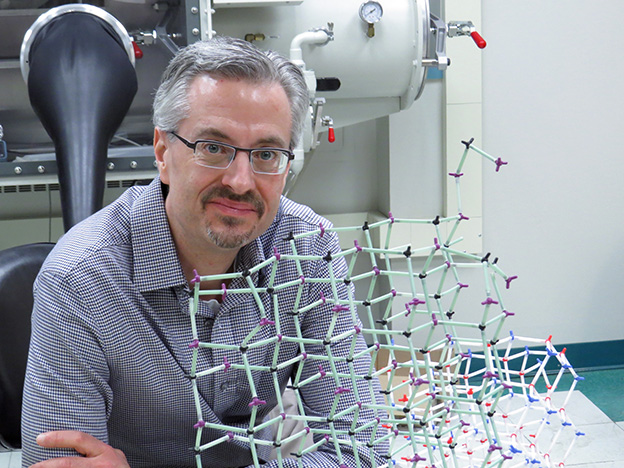McMaster awarded more than $2.3M for projects that grow economy

Ray LaPierre, professor and chair of the Department of Engineering Physics, is one of only two researchers in the country to garner two Strategic Partnership Grants from NSERC: one for a project that will develop more efficient solar cells, the other to advance the field of infrared photodetection.
Seven McMaster researchers have been awarded more than $2.3 million from the Natural Sciences and Engineering Research Council (NSERC) to work with industry to grow the economy and create jobs.
Ray LaPierre, professor and chair of the Department of Engineering Physics, is one of only two researchers in the country to garner two Strategic Partnership Grants from NSERC: one for a project that will develop more efficient solar cells, the other to advance the field of infrared photodetection.
LaPierre envisions a world where sunny skies turn solar panels the darkest of blacks, and people can use their cell phone as infrared cameras to scan their homes for heat loss. Central to LaPierre’s research program are nanowires, structures whose diameter is 1/1000th the size of a human hair.
Those bluish solar panels we see in farmer’s fields convert only 15 to 20 per cent of solar energy into electricity. Ideally, those panels should be black – absorbing as much sunlight as possible, rather than losing as much as 30 per cent to reflection.
“The central challenge in photovoltaic (solar cell) design is to bridge the gap between efficiency and cost. The nanowires developed in my lab have much higher efficiencies due to their superior light absorption and their ability to convert as much as 30 to 40 per cent more solar energy to electricity,” says LaPierre.
The Nanowire photovoltaics project was awarded $420,000 and partners with solar technology company Morgan Solar. LaPierre was also the recipient of a $476,000 grant to use nanowires for the project: A new platform for semiconductor manufacturing with an emphasis in multi-spectral infrared cameras with industry partner Teledyne Dalsa.
The technology will be invaluable in the areas of infrared scanning to detect faults or defects in manufacturing processes, capture more information with astronomical cameras and telescopes, ensure automotive safety, as well as improve surveillance, search and rescue, and defense applications.
Allison Sekuler, interim vice-president of research says “NSERC’s Strategic Partnership program states clearly that they are looking for transformative technologies. McMaster’s five successful research projects affirm our University is at the vanguard of research in the critically important areas of materials, advanced manufacturing and biomedical engineering. The projects awarded will be making a difference in the lives of Canadians in as little as three year’s time.”
At today’s announcement, Kirsty Duncan, Minister of Science said: “On behalf of the Government of Canada, I would like to congratulate all of today’s recipients. This support represents a big investment in connecting our country’s talented scientists and engineers with industry.”
Chemical engineers Todd Hoare and David Latulippe will use their $370,300 award to leverage the combined expertise of Hoare’s lab (bioactives delivery and tissue engineering) with Latulippe’s lab (bioseparations and environmental adsorption technologies) in partnership with Canadian biotechnology company Ceapro and their novel processing technique. Their project Development and application of highly tunable porous biopolymer and smart polymer scaffolds using pressurized gas expanded liquids will improve delivery of drugs and agricultural chemicals, generate 3D cell scaffolds maintaining high cell viability, generate low-cost alternatives for purification of antibodies and viruses, improve methods of removing heavy metal ions from industrial waste water, and enhance the capture of carbon dioxide from polluted air.
Michael Brook, professor, chemistry & chemical biology is leading Reactive Silicone Inks for 3-D Printing Using Microfluidic Mixers. The project was awarded $549,500 to develop rapidly curing silicone inks that can be printed directly from current 4-colour inkjet printers. The project combines Brook’s synthetic expertise with the microfluidic expertise of mechanical engineer Ravi Selvaganapathy, in partnership with three companies: Structur3d Printing, Silcotech and Siltech. These reactive inks will be used as surface treatments of existing devices based on silicone or other materials, ranging from contact lenses to computer keyboard springs.
Gillian Goward, associate professor, chemistry & chemical biology has been awarded $567,780 for the project High resolution in situ imaging and inverse modeling of lithium batteries. Working with Bartosz Protas, professor, mathematics & statistics and industry partners General Motors Canada and Bruker Biospin Canada, Goward will develop novel experimental methods for characterizing transport in lithium ion battery electrolytes, and model the performance of the electrolytes under a range of conditions that mimic real-world driving conditions. This research program aims to increase the rate of adoption of electric vehicle technology in the mass consumer market, which can only be achieved with increased Lithium-Ion battery performance reliability, which relies directly on accurate modeling.

